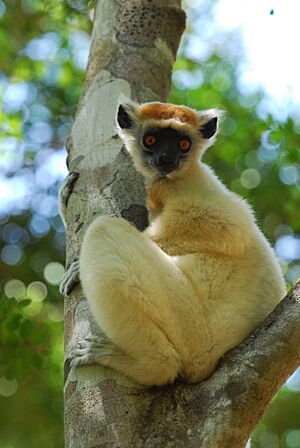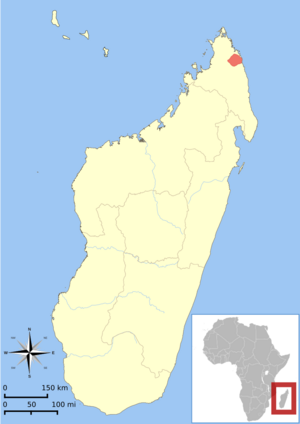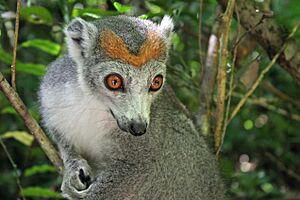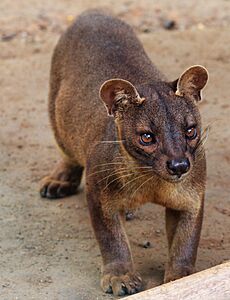Golden-crowned sifaka facts for kids
Quick facts for kids Golden-crowned sifaka |
|
|---|---|
 |
|
| Conservation status | |
| Scientific classification | |
 |
|
| Distribution of P. tattersalli |
The golden-crowned sifaka (Propithecus tattersalli) is a medium-sized lemur from Madagascar. It has mostly white fur, fluffy ears, and a bright golden-orange patch on its head. This sifaka is one of the smallest of its kind. It weighs about 3.5 kg (7.7 lb) and is around 90 cm (35 in) long from head to tail.
Like all sifakas, it is amazing at climbing and leaping between trees. Its diet includes mostly seeds and leaves. The golden-crowned sifaka is named after Ian Tattersall, who first saw it in 1974. Scientists officially described it in 1988. This happened after a team led by Elwyn L. Simons studied some of these animals.
Golden-crowned sifakas live in gallery, deciduous, and semi-evergreen forests. They are found in a small area around Daraina in northeast Madagascar. Scientists believe there are about 18,000 of them. They are mostly active during the day. They sleep in very tall trees. The fossa is a main predator of this sifaka.
These sifakas live in groups of about five or six. They use scent to mark their territories. They defend their areas by growling and chasing other groups. They have babies at certain times of the year. Babies are born after six months and drink milk for five months.
The golden-crowned sifaka is in danger because its home is shrinking. Forest fragmentation, habitat destruction, poaching, and slash-and-burn farming threaten them. The IUCN Red List calls it Critically Endangered. A new protected area, Loky-Manambato reserve, was created in 2005 to help protect them.
Contents
Discovering the Golden-Crowned Sifaka
The golden-crowned sifaka is also known as Tattersall's sifaka. Local people call it ankomba malandy, which means "white lemur". Ian Tattersall first saw this sifaka in 1974 in northeast Madagascar. He saw it but did not capture it.
At first, Tattersall thought it might be a type of silky sifaka. This was because of its off-white fur. But he also noticed its unique orange head patch and tufted ears. In 1986, a forest where this sifaka lived was going to be cut down. Because of this, a research team from the Duke Lemur Center decided to act.
The team, led by Elwyn L. Simons, got permission to capture some sifakas. They wanted to start a captive breeding program. Simons and his team were the first to capture and study the golden-crowned sifaka. In 1988, they officially named it a new species. They named it after Tattersall. The first captured sifakas were found near Daraina village.
Scientists have studied the golden-crowned sifaka's chromosomes. These studies help them understand how it is related to other sifakas. Some studies show it is more like western sifakas. Other studies suggest it is closer to eastern sifakas. But its unique ear tufts and isolated home make it a distinct species.
What Does a Golden-Crowned Sifaka Look Like?
The golden-crowned sifaka is one of the smallest sifaka species. It weighs between 3.4 and 3.6 kg (7.5 to 7.9 lb). Its head and body are about 45 to 47 cm (18 to 19 in) long. Its tail is also long, about 42 to 47 cm (17 to 19 in). So, its total length is around 87 to 94 cm (34 to 37 in).
It has creamy-white fur with a golden tint. Its neck and throat have dark black or chocolate-brown fur. The tops of its legs and arms have pale orange fur. Its tail and back legs are white. The most special feature is its bright orange-gold crown on its head.
This sifaka is the only one with noticeable tufts of white fur sticking out from its ears. This makes its head look a bit triangular. Its eyes are orange, and its face is mostly hairless and black. It has a blunt, rounded nose. This helps tell it apart from other sifakas. Like other sifakas, it has long, strong legs. These legs help it cling and leap between trees.
Where Golden-Crowned Sifakas Live

The golden-crowned sifaka lives in dry deciduous, gallery, and semi-evergreen forests. It can be found up to 500 meters (1,600 ft) high. But it seems to prefer lower areas. Studies show it lives in many small forest patches. These patches are around the town of Daraina in northeast Madagascar.
This sifaka has one of the smallest living areas of all indriid lemurs. Researchers found it in only 44 out of 75 forest patches they studied. These patches cover about 44,125 hectares (109,030 acres). A study in 2002 estimated the total population. It also looked at how many sifakas lived in each area.
Each group of sifakas uses a home range of about 0.18 to 0.29 square kilometers (0.069 to 0.11 sq mi). A group usually has five sifakas. This means there are about 17 to 28 sifakas per square kilometer. A 2010 study estimated the total population to be around 18,000 sifakas.
The golden-crowned sifaka shares its home with two other medium-sized lemurs. These are the Sanford's brown lemur and the crowned lemur.
Daily Life and Behavior
The golden-crowned sifaka is mostly active during the day. But researchers have seen it active in the early morning and evening during the rainy season. This is from November to April. In zoos, they have even been seen eating at night.
These sifakas travel between 461.7 and 1077 meters (1,515 and 3,533 ft) each day. This is an average distance compared to other sifakas. During the dry season (May to October), they eat and rest higher up in the trees. At night, they sleep in the tallest trees of the forest.
When they are stressed, golden-crowned sifakas make grunting sounds. They also make repeated "churrs" that can get very loud. Their alarm call for predators on the ground sounds like "shē-fäk". This is similar to the call of the Verreaux's sifaka. They also make alarm calls when they see birds of prey.
What Golden-Crowned Sifakas Eat
The golden-crowned sifaka eats many different kinds of plants. It can eat up to 80 different plant species. What they eat depends on the season. Seeds are a main part of their diet all year round. They also eat unripe fruits, flowers, and leaves.
One study showed their diet was:
- 37% unripe fruit and seeds
- 22% young leaves
- 17% mature leaves
- 13% flowers
- 9% fruit pulp
Sometimes, they eat tree bark during the dry season. About 60% of their diet is unripe fruits and seeds, especially from bean pods. Less than 50% of their diet is leaves. They eat young leaves and flowers when they are available, usually in the early wet season.
When food is spread out, they spend less time eating and more time traveling. Eating a variety of foods is important for them. It helps them get different nutrients and protects them from plant toxins.
How Golden-Crowned Sifakas Live Together
Golden-crowned sifakas live in groups, much like Verreaux's sifakas. A group usually has five to six sifakas. The number can range from three to ten. Unlike Verreaux's sifakas, their groups have an equal number of males and females. Female sifakas are in charge of the group. Only one female has babies each season. Males may move between groups during mating season.
Because their home ranges are smaller, groups meet each other more often. This happens a few times a month. Golden-crowned sifakas can be more easily annoyed than other sifakas. When they are upset, they often make a grunt-like sound.
When groups meet, they usually don't fight physically. Instead, they growl loudly, mark their territory with scent, chase each other, and do special leaping displays. Scent marking is the most common way they defend their territory. These scent marks act like "signposts" to show where their area ends.
Golden-Crowned Sifaka Reproduction and Life Cycle
The golden-crowned sifaka has a specific breeding season. They often mate during the last week of January. Their gestation period (how long the baby is in the mother) is a little less than six months. They feed their babies milk for five months.
Having babies is linked to the forest seasons. Gestation starts in late January. Babies are born in late June or July, in the middle of the dry season. Weaning (when babies stop drinking milk) happens in December. This is in the middle of the wet season, when there are many young leaves. This timing helps the mother and baby get enough protein from the young leaves.
Females have babies once every two years. Newborns have little hair and cling to their mother's belly. As they grow, they ride on her back. After weaning, they only ride for short times, especially if there's danger. By one year old, young sifakas are 70% of their adult weight. Many young sifakas do not survive.
When males become old enough, they leave their birth group. They then join other groups. Researchers have seen these sifakas jump to the ground and cross open areas. They can cross over 200 meters (660 ft) of grassland to reach other forest patches. This suggests that small forest areas might not completely separate sifaka groups.
Who Hunts Golden-Crowned Sifakas?

The only known animal that hunts the golden-crowned sifaka is the fossa. However, these sifakas also make alarm calls when they see birds of prey.
Scientists have studied the blood of wild golden-crowned sifakas. A study in 1995 found that 59% of them had a tiny worm-like parasite. This parasite is a type of nematode. Infected sifakas seemed healthy. But scientists don't know the full effect on the small population. No malaria or intestinal parasites were found. But 48% of the sifakas had external ear mites.
How Humans Affect Golden-Crowned Sifakas
Golden-crowned sifakas face many threats from humans. Their forest home has been broken into many small pieces. These forest patches are separated by damaged grasslands. By 1985, about 34% of Madagascar's eastern rainforest was gone. It was predicted that by 2020, there might be no eastern rainforest left.
Many human activities cause this deforestation:
- Illegal logging (cutting down trees illegally)
- Slash-and-burn agriculture (called tavy)
- Uncontrolled grass fires
- Gold mining
- Poaching (illegal hunting)
- Clearing land for farming
Farmers in Madagascar still use fire to clear land for crops and livestock. These fires can burn out of control and destroy forests. This causes even more damage. Tavy also makes the soil less fertile. This means farmers need to clear new forest areas more often.
People also cut down trees for cooking fuel and building materials. This is especially true near villages. A study in 2002 found that 5% of small to medium-sized forest patches had disappeared in just six years. This was due to more human activity.
A new threat is hunting by gold miners. Even small mining operations can harm forests. They dig deep pits near or under large trees, which can kill the trees. The arrival of gold miners has also led to more poaching. Local traditions around Daraina usually protect the sifakas from hunting. But gold miners who have moved to the area hunt them for food.
In 1993, researcher David M. Meyers worried that if hunting increased, the sifaka could disappear in less than ten years. This is because they are easy to find and not afraid of humans. People from nearby Ambilobe have already hunted one group of sifakas until they were gone.
Protecting Golden-Crowned Sifakas
Golden-crowned sifakas are sensitive to forest fragmentation. This means they are affected when their forest home is broken into smaller pieces. They are most often found in large forest areas. However, they can also live near gold mining camps and in damaged forests. This shows they can handle some human activity.
But with a small population and a shrinking home, their future is uncertain. Because of this, the International Union for Conservation of Nature (IUCN) listed it as one of the 25 most endangered primates in 2000. In 2014, the golden-crowned sifaka was listed as "Critically Endangered" on the IUCN Red List.
The area where these sifakas live is also important for people. Conservation efforts focus on protecting forest patches. Some areas might allow human activity, while others are strictly protected. In 2002, none of the sifaka's habitat was part of a protected national park or reserve.
A study in 1989 suggested creating a national park. A more recent study in 2002 proposed a network of protected forest areas. In 2005, a Malagasy organization called Fanamby teamed up with Conservation International. They created a 20,000-hectare (49,000-acre) protected area. As of 2008, only ten forest patches could support healthy sifaka populations.
Only one group of golden-crowned sifakas has ever lived in a zoo. The Duke Lemur Center (DLC) in Durham, North Carolina, got permission to bring some sifakas to the US. They wanted to start a captive breeding program. In 1987, two males and two females were caught. In 1988, a golden-crowned sifaka was born at the DLC.
However, the captive group was too small to breed for a long time. Sifakas are also hard to keep in captivity because they have special dietary needs. The last captive sifaka died in 2008. Even though the captive group is gone, the DLC believes that having a captive population is important. It could be a backup plan if habitat protection fails.
Impact of the 2009 Political Crisis
A political crisis began in Madagascar in 2009. This led to a breakdown of law and order. As a result, poachers started hunting lemurs in the Daraina area. They sold them to local restaurants as a special food. Pictures of dead, smoked lemurs were released in August 2009. These pictures included the endangered golden-crowned sifaka.
Around that time, 15 people were arrested for selling smoked lemurs. Hunters sold them for about 1,000 Malagasy ariary (about US$0.53). Restaurants then sold them for 8,000 ariary (US$4.20). Russell Mittermeier, president of Conservation International, said that arrests alone would not stop the poaching.
Images for kids
-
The crowned lemur shares its habitat with the golden-crowned sifaka.
-
The fossa is a predator of the golden-crowned sifaka.








